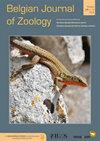海洋Posidonia草甸片脚类对附生生物量的选择性自上而下控制:对生态系统功能的影响
IF 1.1
4区 生物学
Q2 ZOOLOGY
引用次数: 7
摘要
地中海Posidonia oceanica草地是以附生植物为食的片脚类甲壳类动物的重要生物量和生物多样性栖息地。然而,由于缺乏足够的数据,它们对生态系统功能过程的实际意义很难估计。在这里,使用了一个基于田间微观世界的包含实验来测试两足类群落的三个优势类群(Apherusa chiereghini、Dexamine spiniventris和Gammarus spp.)是否可以对海草叶附生植物施加自上而下的控制。还研究了两栖动物活性对寄主物种养分有效性的影响。所有食草动物类群都显著降低了叶片上直立大型藻类和直立无柄动物的生物量。他们中没有一个人食用有外壳的表生植物或表生动物。这种选择性自上而下的控制可能对大洋藻叶片附生群落的结构产生重要影响,大洋藻是所有海草物种中最多样、最丰富的物种之一。所有分类群的放牧活动都导致海草叶片中氮含量较高,可能是通过片脚类排泄和/或草率进食。由于P.oceanica草地通常生长在营养有限的贫营养区,这种氮的富集可以提高海草的产量。总的来说,P.oceanica和片脚类之间的生态相互作用可以看作是一种兼性互惠关系。我们的研究结果表明,片脚类中食草动物是调节这些复杂但濒危的生态系统的一些功能过程的关键元素,而这些生态系统是地中海沿海地区的重要组成部分。本文章由计算机程序翻译,如有差异,请以英文原文为准。
Selective top-down control of epiphytic biomass by amphipods from Posidonia oceanica meadows: implications for ecosystem functioning
Mediterranean Posidonia oceanica meadows shelter an important biomass and biodiversity of amphipod crustaceans that graze on epiphytes. However, their actual significance for ecosystem functional processes is hard to estimate, due to the lack of adequate data. Here, a field microcosm-based inclusion experiment was used to test if three of the dominant taxa of the amphipod community ( Apherusa chiereghinii , Dexamine spiniventris and Gammarus spp.) could exert top-down control on seagrass leaf epiphytes. Influence of amphipod activity on nutrient availability for the host species was also investigated. All grazer taxa significantly reduced biomasses of erect macroalgae and erect sessile animals present on leaves. None of them consumed encrusting epiflora or epifauna. This selective top-down control could have important implications for the structure of the epiphytic community on leaves of P. oceanica , which is one of the most diverse and abundant of all seagrass species. Grazing activity of all taxa caused higher N content of seagrass leaves, likely through amphipod excretion and/or sloppy feeding. Since P. oceanica meadows often grow in oligotrophic zones where plant growth can be nutrient-limited, this N enrichment could enhance seagrass production. Overall, the ecological interaction between P. oceanica and amphipods could be seen as a facultative mutualistic relationship. Our results suggest that amphipod mesograzers are key-elements in some of the functional processes regulating these complex and yet endangered ecosystems, which are essential components of Mediterranean coastal zones.
求助全文
通过发布文献求助,成功后即可免费获取论文全文。
去求助
来源期刊

Belgian Journal of Zoology
生物-动物学
CiteScore
1.90
自引率
0.00%
发文量
10
审稿时长
>12 weeks
期刊介绍:
The Belgian Journal of Zoology is an open access journal publishing high-quality research papers in English that are original, of broad interest and hypothesis-driven. Manuscripts on all aspects of zoology are considered, including anatomy, behaviour, developmental biology, ecology, evolution, genetics, genomics and physiology. Manuscripts on veterinary topics are outside of the journal’s scope. The Belgian Journal of Zoology also welcomes reviews, especially from complex or poorly understood research fields in zoology. The Belgian Journal of Zoology does no longer publish purely taxonomic papers. Surveys and reports on novel or invasive animal species for Belgium are considered only if sufficient new biological or biogeographic information is included.
 求助内容:
求助内容: 应助结果提醒方式:
应助结果提醒方式:


